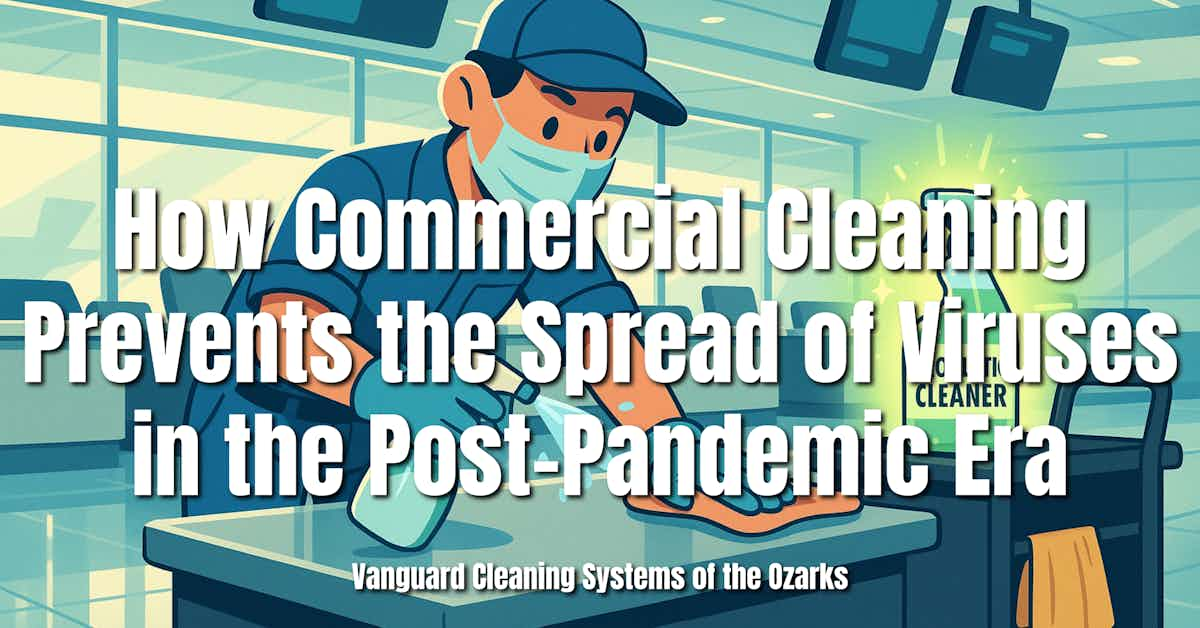Clean surfaces do more than shine—they break the chain of viral spread.

Why Commercial Cleaning Still Matters for Virus Prevention
The pandemic redefined what clean really means. From grocery stores and offices to hospitals and airports, the expectation for sanitized spaces became non-negotiable. But surface cleaning isn’t just about appearances—it’s a frontline defense against viral transmission.
In today’s high-risk, high-touch environments, effective cleaning reduces exposure to harmful viruses like influenza and SARS-CoV-2. It involves more than wiping down surfaces; it requires the right products, proper application, trained staff, and consistent execution. Whether using traditional disinfectants or eco-friendly innovations, commercial cleaning remains one of the most visible and impactful ways to protect public health.
Probiotic Cleaning Offers Residual Protection
Probiotic cleaning doesn’t stop working when it dries—it keeps going for hours. These eco-sustainable cleaners use Bacillus spores, beneficial microbes that form a protective biofilm on surfaces. That biofilm keeps harmful pathogens in check long after the initial wipe-down.
Here’s why it matters:
- Kills up to 99.99% of enveloped viruses (like SARS-CoV-2 and Influenza A) within 1–2 hours
- Continues protecting for up to 24 hours after application
- Reduces recontamination risk between routine cleanings
- Avoids microbial resistance often linked to overuse of chemical disinfectants
In busy environments—offices, schools, airports—this long-lasting defense supports cleaner, safer surfaces with fewer chemicals and less frequent reapplication.
Conventional Disinfectants Are Effective with Proper Use
Traditional disinfectants still play a critical role in reducing virus spread—if they’re used correctly. Products like bleach, alcohol, vinegar, and dish soap are proven to deactivate viruses on surfaces, including influenza and coronaviruses.
To work effectively, disinfectants need:
- Correct concentration – Over-diluting reduces germ-killing power
- Sufficient contact time – Most require at least 30 seconds to several minutes to fully deactivate viruses
- Regular reapplication – Many lose effectiveness within 2 hours after drying
Missteps like wiping too soon, using expired products, or skipping label instructions can undermine even the most powerful cleaners. In offices, healthcare settings, and public buildings, consistent protocols make the difference between surface-level cleaning and actual viral protection.
Healthcare and Dental Environments Require Targeted Disinfection
Medical and dental facilities face unique disinfection demands. High-touch surfaces, patient turnover, and exposure to bodily fluids increase the risk of virus transmission—making strict, targeted cleaning protocols essential.
Key disinfection practices include:
- Alcohol- and iodine-based solutions for routine surface cleaning
- Between-patient wipe-downs of chairs, counters, and instruments in dental settings
- Strict dwell times and dilution controls to ensure virus inactivation
- Integration with PPE use and hand hygiene for layered protection
These environments cannot afford shortcuts. Surfaces must be cleaned frequently and correctly to prevent fomite-based transmission of viruses like SARS-CoV-2. The combination of effective products and trained staff creates a barrier that protects patients, providers, and support teams.
Airports and Transit Hubs Emphasize Surface Hygiene
In high-traffic environments like airports and transit stations, surface cleanliness has become a public health priority. Travelers touch kiosks, handrails, restroom doors, and armrests—making consistent disinfection essential to reduce viral spread and maintain public trust.
Post-pandemic practices now include:
- Frequent disinfection of high-touch areas like security bins, seats, and check-in counters
- Use of hospital-grade disinfectants to meet sanitation standards
- Visible cleaning crews to reassure travelers and reinforce hygiene commitment
- Restroom monitoring and rapid response teams for peak-hour cleanliness
However, some transportation agencies have scaled back these protocols to cut costs—risking both public health and customer confidence. Maintaining strong hygiene standards isn’t just a safety issue; it’s part of the experience travelers expect.
Staff Training Directly Impacts Disinfection Quality
Even the best disinfectants fail without proper application—and that depends on training. Cleaning staff must know how, when, and where to apply products to ensure effectiveness and safety.
Well-trained teams show measurable improvements in:
- Product knowledge – Understanding correct dilution, dwell times, and surface compatibility
- Application technique – Avoiding cross-contamination and ensuring full coverage
- Protective equipment use – Wearing gloves, masks, and goggles when required
- Compliance with protocols – Following facility-specific cleaning checklists and schedules
Video-based training modules have proven especially effective in hospitals and high-risk settings. When staff know the “why” behind the “how,” cleaning shifts from routine to strategic—directly reducing the risk of virus transmission.
High-Touch Surface Cleaning Remains Essential
While airborne transmission gets much of the attention, surfaces still matter—especially in high-traffic, shared environments. Viruses can linger on objects people touch every day, making surface cleaning a critical layer of defense.
Areas that demand constant attention include:
- Doorknobs, elevator buttons, and light switches
- Restroom faucets, handles, and stall locks
- Shared desks, phones, and computer equipment
- Handrails, countertops, and breakroom tables
Even when ventilation and masking are in place, these surfaces act as transmission hotspots. Regular disinfection helps lower surface viral load and reduces the chance of indirect spread—particularly in spaces used by multiple people throughout the day.
Frequently Asked Questions
Do probiotics really work for cleaning viruses?
Yes. Probiotic cleaners use beneficial bacteria to form a protective biofilm that reduces virus survival on surfaces for up to 24 hours.
Are traditional disinfectants still effective?
They are—when used correctly. Bleach, alcohol, and vinegar deactivate viruses, but only if applied at the right concentration and left on surfaces long enough.
Why is surface cleaning still important post-pandemic?
High-touch areas like doorknobs and switches remain hotspots for virus transfer. Regular cleaning helps reduce risk, even in well-ventilated spaces.
What’s the role of training in cleaning effectiveness?
Proper training improves how staff use products, follow protocols, and avoid mistakes. It directly impacts infection control success.
Do all environments need the same cleaning methods?
No. Healthcare, transit, offices, and retail spaces require different products, schedules, and procedures based on usage and exposure risk.
Can cutting cleaning budgets affect safety?
Yes. Reducing frequency or quality of cleaning—especially in public spaces—can increase the risk of viral spread and lower public trust.
References
- D’Accolti, M., Soffritti, I., Bonfante, F., Ricciardi, W., Mazzacane, S., & Caselli, E. (2021). Potential of an Eco-Sustainable Probiotic-Cleaning Formulation in Reducing Infectivity of Enveloped Viruses. Viruses, 13. https://doi.org/10.3390/v13112227
- Greatorex, J., Page, R., Curran, M., Digard, P., Enstone, J., Wreghitt, T., Powell, P., Sexton, D., Vivancos, R., & Nguyen-Van-Tam, J. (2010). Effectiveness of Common Household Cleaning Agents in Reducing the Viability of Human Influenza A/H1N1. PLoS ONE, 5. https://doi.org/10.1371/journal.pone.0008987
- Dhadse, P., Oza, R., & Bhombe, K. (2022). Disinfectants for dental setting in Coronavirus Disease 2019 Era. Journal of Datta Meghe Institute of Medical Sciences University, 17, 83 - 87. https://doi.org/10.4103/jdmimsu.jdmimsu_438_21
- J, B., Ak, B., & R, F. (2020). Infection prevention and control: Key measures in healthcare settings to reduce the spread of COVID-19 pandemic. Journal of Medical and Scientific Research. https://doi.org/10.17727/JMSR.2020/8S1-16
- Florido-Benítez, L. (2023). Cleaning and Hygiene in the Air Transport Industry after the COVID-19 Pandemic. Hygiene. https://doi.org/10.3390/hygiene3040028
- Singh, V., Narula, H., Supehia, S., Sharma, M., Gupta, P., Sharma, A., & Rao, S. (2021). Impact of Video Modules-Based Training on Knowledge, Attitude, and Practices of Cleaning and Disinfection Among Housekeeping Staff at a Tertiary Care Center During the COVID-19 Pandemic. Cureus, 13. https://doi.org/10.7759/cureus.19125
- Kapoor, A., & Saha, R. (2020). Hand washing agents and surface disinfectants in times of Coronavirus (COVID-19) outbreak. Indian Journal of Community Health. https://doi.org/10.47203/ijch.2020.v32i02supp.008
Summary Implications
Effective commercial cleaning remains a cornerstone of infection control in the post-pandemic world. From hospitals to airports to everyday office spaces, the research is clear—clean surfaces help stop the spread of viruses.
Key takeaways include:
- Probiotic cleaners offer longer-lasting protection with eco-friendly benefits
- Traditional disinfectants work well, but only when used correctly and consistently
- High-risk environments require targeted, protocol-driven cleaning routines
- Trained staff are the frontline defense against cleaning errors and oversights
- High-touch surfaces still pose daily risks without regular disinfection
Whether using advanced solutions or everyday products, the focus must stay on consistency, training, and strategic cleaning. In a world more aware than ever of viral risks, the role of professional cleaning has shifted—from maintenance to mission-critical.
Vanguard Cleaning Systems of the Ozarks' franchise-owned custodial service provider business cleans more than 8M sq. ft. weekly, maintaining an industry-topping 95+% of its customer base, year-over-year, and boasting more than 60 5-star Google reviews.
Need more capability from your vendor partners? --Let's talk.
In Oklahoma, dial 918-960-4450
In Arkansas, dial 479-717-2410
In Missouri, dial 417-812-9777

